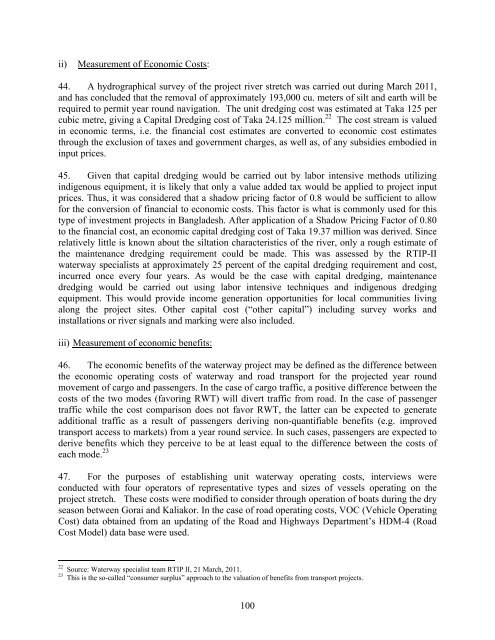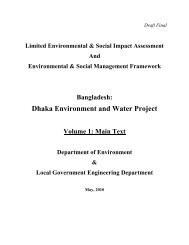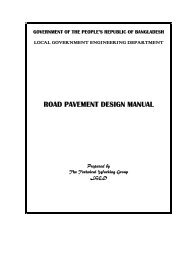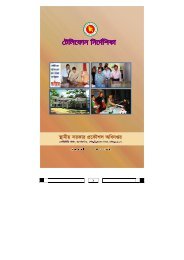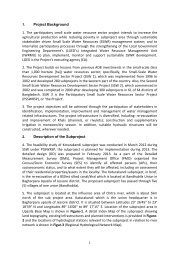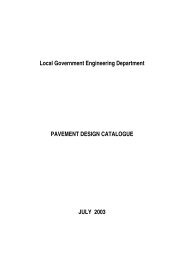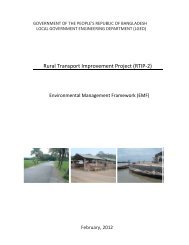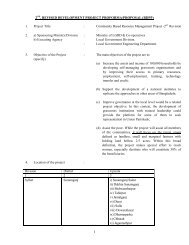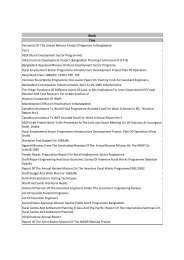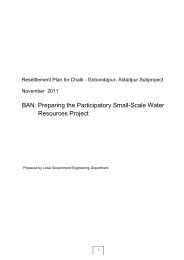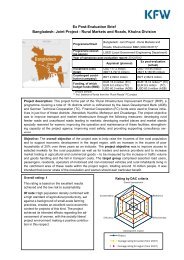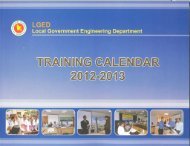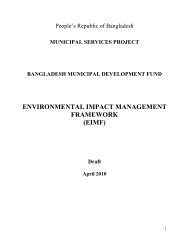PAD - LGED
PAD - LGED
PAD - LGED
You also want an ePaper? Increase the reach of your titles
YUMPU automatically turns print PDFs into web optimized ePapers that Google loves.
ii)<br />
Measurement of Economic Costs:<br />
44. A hydrographical survey of the project river stretch was carried out during March 2011,<br />
and has concluded that the removal of approximately 193,000 cu. meters of silt and earth will be<br />
required to permit year round navigation. The unit dredging cost was estimated at Taka 125 per<br />
cubic metre, giving a Capital Dredging cost of Taka 24.125 million. 22 The cost stream is valued<br />
in economic terms, i.e. the financial cost estimates are converted to economic cost estimates<br />
through the exclusion of taxes and government charges, as well as, of any subsidies embodied in<br />
input prices.<br />
45. Given that capital dredging would be carried out by labor intensive methods utilizing<br />
indigenous equipment, it is likely that only a value added tax would be applied to project input<br />
prices. Thus, it was considered that a shadow pricing factor of 0.8 would be sufficient to allow<br />
for the conversion of financial to economic costs. This factor is what is commonly used for this<br />
type of investment projects in Bangladesh. After application of a Shadow Pricing Factor of 0.80<br />
to the financial cost, an economic capital dredging cost of Taka 19.37 million was derived. Since<br />
relatively little is known about the siltation characteristics of the river, only a rough estimate of<br />
the maintenance dredging requirement could be made. This was assessed by the RTIP-II<br />
waterway specialists at approximately 25 percent of the capital dredging requirement and cost,<br />
incurred once every four years. As would be the case with capital dredging, maintenance<br />
dredging would be carried out using labor intensive techniques and indigenous dredging<br />
equipment. This would provide income generation opportunities for local communities living<br />
along the project sites. Other capital cost (“other capital”) including survey works and<br />
installations or river signals and marking were also included.<br />
iii) Measurement of economic benefits:<br />
46. The economic benefits of the waterway project may be defined as the difference between<br />
the economic operating costs of waterway and road transport for the projected year round<br />
movement of cargo and passengers. In the case of cargo traffic, a positive difference between the<br />
costs of the two modes (favoring RWT) will divert traffic from road. In the case of passenger<br />
traffic while the cost comparison does not favor RWT, the latter can be expected to generate<br />
additional traffic as a result of passengers deriving non-quantifiable benefits (e.g. improved<br />
transport access to markets) from a year round service. In such cases, passengers are expected to<br />
derive benefits which they perceive to be at least equal to the difference between the costs of<br />
each mode. 23<br />
47. For the purposes of establishing unit waterway operating costs, interviews were<br />
conducted with four operators of representative types and sizes of vessels operating on the<br />
project stretch. These costs were modified to consider through operation of boats during the dry<br />
season between Gorai and Kaliakor. In the case of road operating costs, VOC (Vehicle Operating<br />
Cost) data obtained from an updating of the Road and Highways Department’s HDM-4 (Road<br />
Cost Model) data base were used.<br />
22 Source: Waterway specialist team RTIP II, 21 March, 2011.<br />
23 This is the so-called “consumer surplus” approach to the valuation of benefits from transport projects.<br />
100


